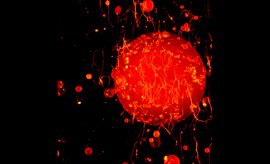Genomic Copy Number Profiling Using Circulating Free Tumor DNA Highlights Heterogeneity in Neuroblastoma
Abstract
Purpose: The tumor genomic copy number profile is of prognostic significance in neuroblastoma patients. We have studied the genomic copy number profile of cell-free DNA (cfDNA) and compared this with primary tumor arrayCGH (aCGH) at diagnosis.
Experimental Design: In 70 patients, cfDNA genomic copy number profiling was performed using the OncoScan platform. The profiles were classified according to the overall pattern, including numerical chromosome alterations (NCA), segmental chromosome alterations (SCA), and MYCN amplification (MNA).
Results: Interpretable and dynamic cfDNA profiles were obtained in 66 of 70 and 52 of 70 cases, respectively. An overall identical genomic profile between tumor aCGH and cfDNA was observed in 47 cases (3 NCAs, 22 SCAs, 22 MNAs). In one case, cfDNA showed an additional SCA not detected by tumor aCGH. In 4 of 8 cases with a silent tumor aCGH profile, cfDNA analysis revealed a dynamic profile (3 SCAs, 1 NCA). In 14 cases, cfDNA analysis did not reveal any copy number changes. A total of 378 breakpoints common to the primary tumor and cfDNA of any given patient were identified, 27 breakpoints were seen by tumor aCGH, and 54 breakpoints were seen in cfDNA only, including two cases with interstitial IGFR1 gains and two alterations targeting TERT.
Conclusions: These results demonstrate the feasibility of cfDNA copy number profiling in neuroblastoma patients, with a concordance of the overall genomic profile in aCGH and cfDNA dynamic cases of 97% and a sensitivity of 77%, respectively. Furthermore, neuroblastoma heterogeneity is highlighted, suggesting that cfDNA might reflect genetic alterations of more aggressive cell clones. Clin Cancer Res; 22(22); 5564–73. ©2016 AACR.
See related commentary by Janku and Kurzrock, p. 5400








